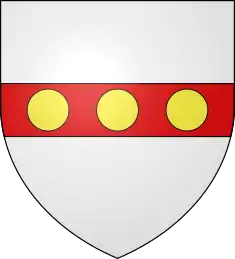Battle of Seminara (1503)
The Battle of Seminara of 1503 took place on 21 April 1503, near Seminara and Gioia Tauro, Calabria, between the French troops under the command of Bérault Stuart d'Aubigny and the Spanish troops commanded by Don Fernando de Andrade during the Second Italian War.
| Battle of Seminara | |||||||
|---|---|---|---|---|---|---|---|
| Part of the Third Italian War | |||||||
| |||||||
| Belligerents | |||||||
|
|
| ||||||
| Commanders and leaders | |||||||
|
|
| ||||||
| Strength | |||||||
|
4,500 infantry 900 cavalry[2] |
4,000 infantry 800 cavalry[2] | ||||||
Background
In November 1500 both Louis XII of France and Ferdinand II of Aragon signed the Treaty of Granada, still under Frederick IV of Naples´s rule, in which they agreed to share the Kingdom of Naples, equally.
In 1501 the French army under Bérault Stuart d'Aubigny penetrated into Naples from the North, while the Spanish army commanded by Don Gonzalo Fernández de Córdoba occupied the southern part. Frederick IV was overthrown and his kingdom divided between the two occupying forces, as stipulated in the treaty. There were soon signs of dissent growing between the Spanish and the French for the possession for the area that divided their territories and by June, 1502, armed conflict broke out between them.
The more numerous French forces were divided into two; the French Viceroy of Naples Louis d'Armagnac remained in Apulia surrounding Gonzalo Fernández de Córdoba in Barletta while Stuart d'Aubigny pursued the Spanish forces under Hugo de Cardona and Manuel de Benavides in Calabria.
At the start of 1503 it seemed that peace was descending, due mainly to the diplomatic negotiations that Philip I of Castile, son in law of Ferdinand II of Aragon had made with the French King signing the Treaty of Lyon, but Ferdinand's refusal to ratify the agreement, left things as they were.

The battle
In February the Spanish fleet set sail from Cartagena, headed for Naples and sent by King Ferdinand to support Gonzalo de Córdoba guided by Luis Portocarrero, with 40 ships, 600 cavalry and 2,000 infantry aboard, and arrived in Messina on 5 March.[3] Shortly after Portocarrero died, leaving Don Fernando de Andrade as his successor in command of the Spanish forces.
On hearing about the Spanish reinforcements, Bérault Stuart d'Aubigny gathered together 200 horsemen and 800 infantry and marched towards Terranova. Faced with the arrival of Spanish reinforcements he lifted the siege of Terranova and marched towards San Martino, meanwhile Fernando de Andrade gathered all his troops in Seminara. After negotiating, both sides agreed to do battle the following Friday 21 April. On the agreed date both armies met up half way between Seminara and Gioia Tauro. In the ensuing battle the Spanish defeated the French army, who retreated northbound while being chased and harassed by the Spanish.
Consequences
Finally Bérault Stuart d'Aubigny would be besieged in Castel Angitola, where he surrendered 30 days later.[4] After that he was taken to Castel Nuovo as a prisoner.[1] Once the French army had been defeated, the Province of Calabria was left under Spanish control. One week after this military confrontation, Don Gonzalo Fernández de Córdoba would defeat the French in the Battle of Cerignola, again changing the direction of the war, after which, would turn in Spain's favour.
Notes
- Historia manuscrita p.374
- Zurita Vol. V/cap. XXV
- Zurita Vol. V/cap. X
- Pulgar. Conquistas del Reino de Nápoles p.169
References
- Juan de Mariana, José Sabau y Blanco, Madrid. Historia general de España
- Paolo Giovio, Vita di Consalvo Fernando di Cordova, Detto Il Gran Capitano. In Spanish by Pedro Blas Torrellas.
- Jerónimo Zurita, Historia del rey Don Fernando el Católico. De las empresas, y ligas de Italia
- Hernán Pérez del Pulgar, Coronica llamada las dos Conquistas del Reino de Nápoles. Crónicas del Gran Capitán
- Batista González, Juan (2007). España Estratégica. Guerra y Diplomacia en la Historia de España. Sílex. ISBN 978-84-7737-183-0